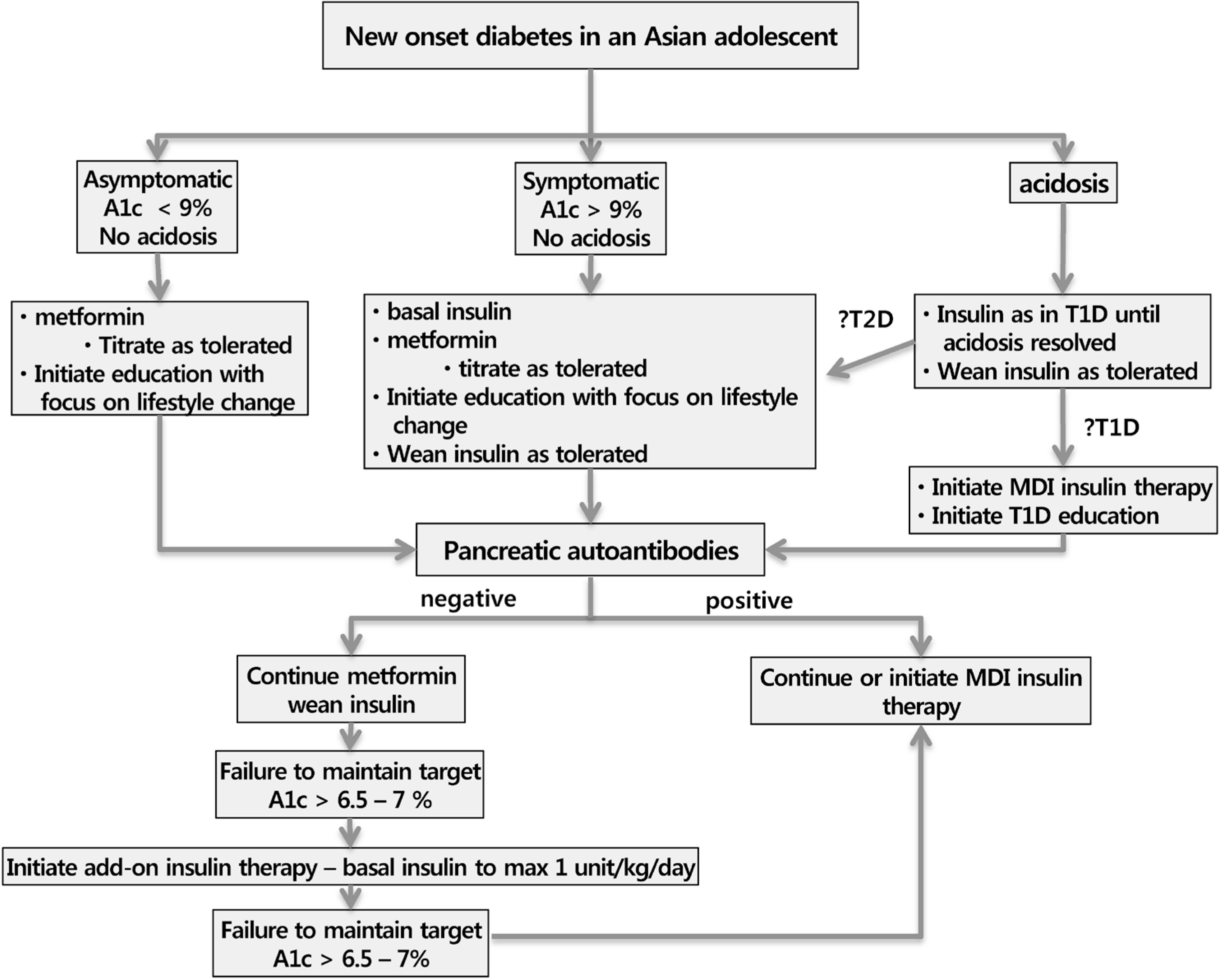Abstract
Diabetes among young patients in Korea is caused by a complex set of factors. In addition to the typical T1aD and T2D patients, there is a variable incidence of cases of non-autoimmune types of T1D associated with insulin deficiency (T1b), such as fulminant T1D (FT1D). Although T1a is the major type of childhood diabetes, FT1D exists as a hyper-acute subtype of T1D that affects older children, without causing autoimmunity. They showed a complete loss of β-cell secretory capacity without evidence of recovery, necessitating long-term treatment with insulin. In addition, latent autoimmune diabetes in adults (LADA) is a form of autoimmune-mediated diabetes, usually diagnosed based on GAD autoantibody positivity. Although many epidemiological surveys of LADA have been conducted in Caucasian and Asian populations, their reported prevalence rates vary due to the use of different diagnostic criteria. In a recent study with a comparable design and valid methodology, the prevalence of LADA using GAD autoantibody positivity as the diagnostic criterion was higher (4.4%) than the previously reported prevalence of 1.7% in a population-based T2D survey. After 36 months of follow-up, only 3 of the 39 patients initially diagnosed with LADA had become insulin-dependent, and they were all positive for multiple autoantibodies (GAD, IA-2 and ZnT8 antibody). This demonstrates that true insulin dependency, which was initially indicated by multiple antibody positivity, has not increased in the Korean population. Therefore, despite etiological heterogeneity, in the clinical setting, early diagnosis and classification of patients with diabetes relying on clinical grounds without measuring autoantibodies could be a possible method to minimize complications.
References
1. American Diabetes Association. Diagnosis and classification of diabetes mellitus. Diabetes Care. 2006; 29(Suppl 1):S43–8.
2. Balasubramanyam A, Nalini R, Hampe CS, Maldonado M. Syndromes of ketosis-prone diabetes mellitus. Endocr Rev. 2008; 29:292–302.

3. Park Y, Eisenbarth GS. Genetic susceptibility factors of Type 1 diabetes in Asians. Diabetes Metab Res Rev. 2001; 17:2–11.

4. Zimmet PZ, Tuomi T, Mackay IR, Rowley MJ, Knowles W, Cohen M, Lang DA. Latent autoimmune diabetes mellitus in adults (LADA): the role of antibodies to glutamic acid decarboxylase in diagnosis and prediction of insulin dependency. Diabet Med. 1994; 11:299–303.

5. Tuomi T, Groop LC, Zimmet PZ, Rowley MJ, Knowles W, Mackay IR. Antibodies to glutamic acid decarboxylase reveal latent autoimmune diabetes mellitus in adults with a non-insulin-dependent onset of disease. Diabetes. 1993; 42:359–62.

6. Maioli M, Pes GM, Delitala G, Puddu L, Falorni A, Tolu F, Lampis R, Orrù V, Secchi G, Cicalò AM, Floris R, Madau GF, Pilosu RM, Whalen M, Cucca F. Number of autoantibodies and HLA genotype, more than high titers of glutamic acid decarboxylase autoantibodies, predict insulin dependence in latent autoimmune diabetes of adults. Eur J Endocrinol. 2010; 163:541–9.

7. Park Y. Type 1 diabetes (T1D) genetic susceptibility markers and their functional implications. J Genetic Med. 2014; 11:1–10.
8. Imagawa A, Hanafusa T, Miyagawa J, Matsuzawa Y. A novel subtype of type 1 diabetes mellitus characterized by a rapid onset and an absence of diabetes-related antibodies. Osaka IDDM Study Group. N Engl J Med. 2000; 342:301–7.
9. Cho YM, Kim JT, Ko KS, Koo BK, Yang SW, Park MH, Lee HK, Park KS. Fulminant type 1 diabetes in Korea: high prevalence among patients with adult-onset type 1 diabetes. Diabetologia. 2007; 50:2276–9.

11. Park Y, She JX, Wang CY, Lee H, Babu S, Erlich HA, Noble JA, Eisenbarth GS. Common susceptibility and transmission pattern of human leukocyte antigen DRB1-DQB1 haplotypes to Korean and Caucasian patients with type 1 diabetes. J Clin Endocrinol Metab. 2000; 85:4538–42.

12. Hawa MI, Kolb H, Schloot N, Beyan H, Paschou SA, Buzzetti R, Mauricio D, De Leiva A, Yderstraede K, Beck-Neilsen H, Tuomilehto J, Sarti C, Thivolet C, Hadden D, Hunter S, Schernthaner G, Scherbaum WA, Williams R, Brophy S, Pozzilli P, Leslie RD. Action LADA consortium. Adult-onset autoimmune diabetes in Europe is prevalent with a broad clinical phenotype: Action LADA 7. Diabetes Care. 2013; 36:908–13.
13. Park Y, Lee H, Koh CS, Min H, Rowley M, Mackay IR, Zimmet P, McCarthy B, McCanlies E, Dorman J, Trucco M. The low prevalence of immunogenetic markers in Korean adult-onset IDDM patients. Diabetes Care. 1996; 19:241–5.

14. Trabucchi A, Faccinetti NI, Guerra LL, Puchulu FM, Frechtel GD, Poskus E, Valdez SN. Detection and characterization of ZnT8 autoantibodies could help to screen latent autoimmune diabetes in adult-onset patients with type 2 phenotype. Autoimmunity. 2012; 45:137–42.

Table 1.
Varying selection criteria for LADA
Table 2.
Comparison of different treatments for LADA
| Study name | Comparison of treatments | No. | HbA1c at 0 to 12 monthsa | Fasting c-peptide at 0 to 12 monthsa | Comments |
|---|---|---|---|---|---|
| UK (Davis, 2005) | Insulin vs. sulfonylurea (FBG < 15 mmol/L) | 235 (all patients type 2 and LADA) | 0.4% | – | CI cannot be calculated |
| Sweden (Agardh, 2005) | Diamyd (GAD65) (20 ug or 100 ug or 500 ug) vs. Placebo/ 4 ug diamyd | 47 |
0.08% (0.4 to 0.7) |
– | |
| Japan (Maruyama, 2008) | Insulin vs. sulfonylurea | 60 |
–0.5 (−1.33 to 0.33) |
– | |
| China (Yang, 2009) | Insulin vs. insulin + rosiglitazone (GAD Ab > 175 U/mL and fasting c-peptide > 3 nmol/L) | 24 |
2.01 (0.15 to 3.87) |
– | |
| China (Zhou, 2005) | Insulin vs. insulin + rosiglitazone | 17 | +1.2% | –0.4 | Estimates based on median values |
| China (Li, 2009) | Insulin vs. insulin + vitamin D | 35 | – | 100 pmol/L | CI cannot be calculated |
| Sweden (Thunander, 2010) | Insulin vs. diet +/- metformin and/or sulfonylurea | 37 |
0.4 (−0.38 to 1.18) |
– | Stimulated C-peptide only reported |
| China (Zhou, 2010) | Insulin vs. insulin + sitagliptin | 30 | No change | 110 pmol/L |




 PDF
PDF ePub
ePub Citation
Citation Print
Print



 XML Download
XML Download